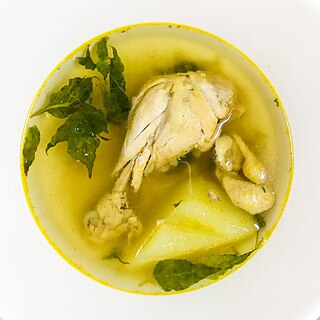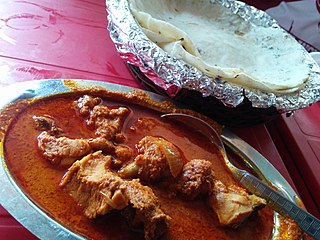Related Research Articles

Chicken soup is a soup made from chicken, simmered in water, usually with various other ingredients. The classic chicken soup consists of a clear chicken broth, often with pieces of chicken or vegetables; common additions are pasta, noodles, dumplings, or grains such as rice and barley. Chicken soup has acquired the reputation of a folk remedy for colds and influenza, and in many countries is considered a comfort food.

Filipino cuisine is composed of the cuisines of more than a hundred distinct ethnolinguistic groups found throughout the Philippine archipelago. A majority of mainstream Filipino dishes that compose Filipino cuisine are from the food traditions of various ethnolinguistic groups and tribes of the archipelago, including the Ilocano, Pangasinan, Kapampangan, Tagalog, Bicolano, Visayan, Chavacano and Maranao ethnolinguistic groups. The dishes associated with these groups evolved over the centuries from a largely indigenous base shared with maritime Southeast Asia with varied influences from Chinese, Spanish and American cuisines, in line with the major waves of influence that had enriched the cultures of the archipelago and adapted using indigenous ingredients to meet local preferences.

Sinigang is a Filipino soup or stew characterized by its sour and savory taste. It is most often associated with tamarind, although it can use other sour fruits and leaves as the souring agent. It is one of the more popular dishes in Filipino cuisine. The soup is usually accompanied by rice. In 2021, sinigang was rated as the world's best vegetable soup by TasteAtlas.

Tinola is a Filipino soup usually served as a Main course with white rice. Traditionally, this dish is cooked with chicken or fish, wedges of papaya and/or chayote, and leaves of the siling labuyo chili pepper in broth flavored with ginger, onions and fish sauce.

Dinuguan is a Filipino savory stew usually of pork offal and/or meat simmered in a rich, spicy dark gravy of pig blood, garlic, chili, and vinegar.

Chicken curry is a dish originating from the Indian subcontinent. It is common in the Indian subcontinent, Southeast Asia, Great Britain, Caribbean, and Japan. A typical curry from the Indian subcontinent consists of chicken stewed in an onion- and tomato-based sauce, flavoured with ginger, garlic, tomato puree, chilli peppers and a variety of spices, often including turmeric, cumin, coriander, cinnamon, and cardamom. Outside of South Asia, chicken curry is often made with a pre-made spice mixture known as curry powder.
KMU may refer to:
Talunan or talonan is a Filipino chicken soup or stew characterized by its sour flavor. It is prepared like a combination of Philippine adobo and paksiw, with vinegar, garlic, ginger, black peppercorns, patis, bay leaves, and salt. Some recipes add pork to the dish. The name literally means "loser" in Tagalog, as it was traditionally cooked from the tough meat of losing roosters used in cockfighting.

Hot and sour soup is a popular example of Sichuan cuisine. Similar versions are found in Henan province, near Beijing, and in Henan cuisine itself, where it may also be known as hulatang or "pepper hot soup" (胡辣汤). Also popular in Southeast Asia, India, Pakistan and the United States, it is a flexible soup which allows ingredients to be substituted or added depending on availability. For example, the American-Chinese version can be thicker as it commonly includes corn starch, whilst in Japan, sake is often added.

Nilaga is a traditional meat stew or soup from the Philippines, made with boiled beef or pork mixed with various vegetables. It is typically eaten with white rice and is served with soy sauce, patis, labuyo chilis, and calamansi on the side.

Afritada is a Philippine dish consisting of chicken, beef, or pork braised in tomato sauce with carrots, potatoes, and red and green bell peppers. It is served on white rice and is a common everyday Filipino meal. It can also be used to cook seafood.

Pininyahang manok, commonly anglicized as pineapple chicken, is a Philippine dish consisting of chicken braised in a milk or coconut milk-based sauce with pineapples, carrots, potatoes, and bell peppers. Some variants of the dish use a chicken stock base instead of milk. The dish originates from Southern Luzon which was once a regional center of pineapple fiber production in the Spanish Philippines.

Sopas is a Filipino macaroni soup made with elbow macaroni, various vegetables, and meat, in a creamy broth with evaporated milk. It is regarded as a comfort food in the Philippines and is typically eaten during breakfast, cold weather, or served to sick people.

Philippine asado refers to two different Filipino braised meat dishes. The name originates from Spanish asado ("grilled"), a reference to the original dish it was applied to, the Chinese-Filipino version of char siu barbecues usually known as pork asado. However, the Filipino versions have evolved to be braised, not grilled. The other Filipino dish also known as asado is asado de carajay. Unlike the Chinese-derived version, it is savory rather than sweet.

Ginataang manok is a Filipino chicken soup made from chicken in coconut milk with green papaya and other vegetables, garlic, ginger, onion, patis or bagoong alamang, and salt and pepper. It is a type of ginataan. A common variant of the dish adds curry powder or non-native Indian spices and is known as Filipino chicken curry.
Inubaran is a Filipino chicken stew or soup made with chicken cooked with diced banana pith, coconut milk (gata) or coconut cream, a souring agent, lemongrass, and various spices. The souring agent is traditionally either batuan fruits or libas leaves. The name means "[cooked] with ubad ", not to be confused with ubod ; although ubod can sometimes be used as a substitute for ubad which can be difficult to acquire. It originates from the Western Visayas and is associated with the cuisines of the Aklanon people. Variants of the dish can also be made with other types of meat or seafood. It is a type of ginataan.
Kadyos, baboy, kag lanka, commonly shortened to KBL, is a Filipino pork soup or stew originating from the Hiligaynon people of the Western Visayas islands. The name of the dish means "pigeon peas, pork, and jackfruit"; the three main ingredients. The soup is also traditionally soured with batuan fruits. Other souring agents like tamarind can also be used. Other ingredients include leafy greens, lemongrass, fish sauce, onions, and siling haba peppers. The pork cut used is typically the hock (pata). The dish is characteristically purple in color due to the use of pigeon peas. It is similar to another Hiligaynon dish known as kadyos, manok, kag ubad which uses chicken and banana pith instead.
Linat-an, also known as nilat-an, is a traditional pork stew from the Visayas and Mindanao islands of the Philippines. Linat-an characteristically uses pork ribs boiled and simmered until very tender, lemongrass, string beans, and starchy ingredients for a thicker soup. Like the very similar nilagang baboy, the rest of its ingredients can vary, but they typically include chayote, water spinach, onion, garlic, pechay, calabaza, and bell peppers. It is seasoned with salt, ground black pepper, and fish sauce to taste.
References
- ↑ "Kadyos Manok Ubad Recipe". Pinoy Recipe At Iba Pa. Retrieved February 14, 2016.
- ↑ "Easy Kadyos- Manok- Ubad Recipe". Ang Sarap! Pinoy Recipes. April 3, 2017. Retrieved February 8, 2021.
- ↑ "Manok at Kadyos / Purple Chicken With Pigeon Peas". Market Manila. October 21, 2007. Retrieved February 8, 2021.
- ↑ "Kadyos Beans". Ark of Taste. Slow Food Foundation for Biodiversity. Retrieved February 8, 2021.
